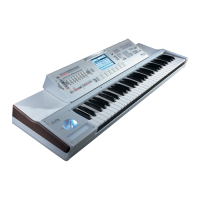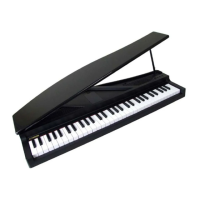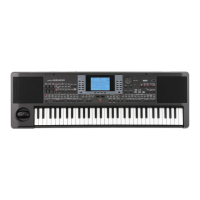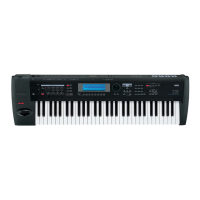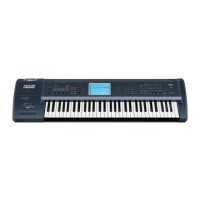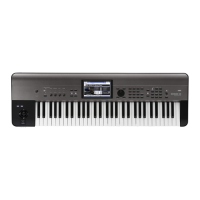Example#!
Combination number
2 Combination name
3 Parameter
of
currently selected cursor position
COMB!
101
Piano+TrP
L~~er
1 Pro9raM
*IQ0
R.Piano
L70
102
TrUMPet
L82
4 Number, name and volume level
of
the program being
used
A 8 C D E F G H
I?\
__..__.__.__.____.__.__.-0
5
Cursorkeys
Example#2
COMB!
-104
MultiCoMbi
IQ1
102
103 Ip5 106
Tl=E.
Bass
109
IIO
I12
A 8 C D E F C H
--------
6
Program
name
of
cursor
position
7
Number
of
the
Program
being used
Example
1
shows
a
display
when
a
Layer
Combination
is
selected.
The
Program
number,
Program
name
and
volume
level
are
indicated
when
the
Combination
is a
Layer
or
Split.
When
replacing
the
Program
of
Layer
1
(Program
number
IOO,
directly
above
cursor
key
[Al
)
with
another
Program,
press
cursor
key
[Al
then
adjust
the
VALUE
dial.
The
display
pages
are
often
laid
out
such
that
one
parameter
description
will
occupy
the
space
over
several
cursor
keys.
The
cursor
keys
just
under
that
parameter
(and
up to the
cursor
key
of
the
next
parameter)
can be
used
to
access
the
parameter.
The
sound
volume
of
Layer
1 can be
changed
by
pressing
cursor
key
[!2]
then
adjusting
the
VALUE
dial
(maximum
= 99,
minimum
= 00).
Press
cursor
key
00]
when
you
want
to
replace
the
Program
of
layer
2.
Press
cursor
key
[HJ
when
changing
the
volume
of
layer
2.
Example
2
shows
a
display
when
a
multi
Combination
is
selected.
As in the
first
example,
the
Program
number
shown
directly
above
cursor
key
[gJ
(Program
number
106)
can
be
changed
by
pressing
cursor
key
[g)
then
by
adjusting
the
VALUE
dial.
IHOW
TO
PLAY
PROGRAMS
(ONE
SOUND
COLOR)
]
(1) Press the PROG key
of
the mode select keys; this puts the
Ml
in the PROGRAM Mode.
(2) Select the number
of
the Program (00 to 99) which you want to play by using the numeric keypad or UP/DOWN
keys.
(3) Play the keyboard to hear the sound
of
the Program selected in step #2.
Here
is a
typical
display
from
the
PROGRAM
mode:
INT
CARD
C:=J
c:::::=:J
:--COMsl-
--
-E01T
COMBr-;
!c=::J
c:::::=:Ji
:
PROG
EDIT
PROG
:
!~~!
: SEQ GLOBAL :
iC:=J
~:
--r.:_:__:_:_:_:_-~~~~-.;~
r---sea--,
START/STOP
REC
C:=J~
,_-Mode Select Key
:--o---
-----
------
5-~
!c=::J
~!
: 1 6 :
!c=::J
~!
! 2 7 :
:c=::J
~:
: 3 8 :
ic=::J
~i
: 4 9 :
:c=::J
~
:
L-------------------
- l
COMPARE
BANK HOLD
c=::J
~
EXAMPLE
~
Cf
.--------------P
~
PROG
100
Universe
OSC
Balance
0+05
F+03
L-02
K+10
U-08
R+01
R-01
E+03
A 8 C D E F G H
--------
1
Program
2
Internal
program
number
3Program
name
4
Parameter
The
display
shown
when
selecting
the
PROGRAM
Mode
is
like
the one above.
While
this
display
is
shown,
the
pressing
of
any
single
cursor
key
and
adjusting
of
the
VALUE
dial will
change
the
value
of
the
parameter,
which
is
indicated
above
the
selected
cursor
key.
In
this way
Programs
may be
easily
edited
without
having
to
enter
the
EDIT
PROGRAM
Mode.
This
is
particularly
convenient
for
making
on-the-spot
sound
changes
during
live
performance.
12
